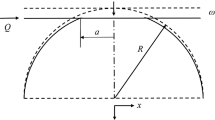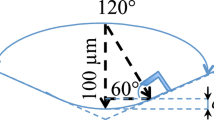Abstract
This work evaluates the friction coefficient using the model of plastic hemispherical contact against a rigid flat. The fractional profile of an ellipsoid is utilized to describe the deformed hemispherical shape, and simultaneously define the contact area ratio. Particularly, an adhesion factor is defined to assess the junction ability of asperity adhesion under compressive loading. Additionally, the complex process of contact is assumed as a series of contact states changing from fracture to shearing. The friction coefficient, which obeys the constant friction law, is then derived as a function of interference and strain hardening exponent via adhesion theory. Finally, a comparison of friction coefficient is made with the published experiment, showing that the calculated value is larger than the experimental value. Some practical conclusions are presented and a conceptual understanding of contact friction is provided.
Similar content being viewed by others
References
P. J. Blau, The significance and use of the friction coefficient, Tribology International, 34 (2001) 585–591.
J. A. Greenwood and J. B. P. Williamson, Contact of nominally flat surfaces, Proc. R. Soc. London, Ser A, 295 (1966) 300–319.
E. J. Abbott and F. A. Firestone, Specifying surface qualitya method based on accurate measurement and comparison, Mech. Eng. Am. Soc. Mech. Eng., 55 (1933) 569–572.
W. R. Chang, I. Etsion and D. B. Bogy, Static friction coefficient model metallic rough surfaces, ASME, J. Tribol., 110 (1988) 57–63.
L. Kogut and I. Etsion, A semi-analytical solution for the sliding inception of a spherical contact, ASME, J. Tribol., 125 (2003) 499–506.
L. Kogut and I. Etsion, A static friction model for elasticplastic contacting rough surfaces, ASME, J. Tribol., 126 (2004) 34–40.
I. Etsion, O. Levinson, G. Halperin and M. Varenberg, Experimental investigation of the elastic-plastic contact and static friction coefficient of a sphere on flat, ASME, J. Tribol., 127 (2005) 47–50.
V. Brizmer, Y. Kligerman and I. Etsion, Elastic-plastic spherical contact under combined normal and tangential loading in full stick, Tribology Letters, 25 (2007) 61–70.
A. Ovcharenko, G. Halperin and I. Etsion, Experimental study of adhesive static friction in a spherical elastic-plastic contact, ASME, J. Tribol., 130 (2008) 021401.
D. Cohen, Y. Kligerman and I. Etsion, The effect of surface roughness on static friction and junction growth of an elastic-plastic spherical contact, ASME, J. Tribol., 131 (2009) 021404.
F. P. Bowden and D. Tabor, The Friction and Lubrication of Solids, Clarendon Press, Oxford (1953).
M. C. Shaw, Metal Cutting Principles, Oxford Press, Oxford (1970).
R. Jackson and I. Green, A finite element study of elasticplastic hemispherical contact against a rigid flat, ASME, J. Tribol., 127 (2005) 343–354.
L. Kogut and I. Etsion, Elastic-plastic contact analysis of a sphere and a rigid flat, ASME, J. Appl. Mech., 69 (5) (2002) 657–662.
M. A.-N. Hassan Mohamed, N. G. El-Sebaie and K. Yamaguchi, An improved punch friction test in sheet metal forming, Journal of the JSTP, 42 (480) (2001) 31–37.
T. Wanheim and N. Bay, A model for friction in metal forming processes, Annuals of the CIRP, 27 (1978) 189–194.
N. Bay, T. Wanheim and B. Avitzur, Models for friction in metal forming, Proc. NAMRC XVII (SME) (1989) 372–379.
U. Engel and R. Eckstein, Microforming-from basic research to its realization, J. Mater. Process. Technol., 125–126 (2002) 35–44.
Author information
Authors and Affiliations
Corresponding author
Additional information
This paper was recommended for publication in revised form by Associate Editor Dae-Eun Kim
Daw-Kwei Leu received M.S. and Ph. D. degrees in Mechanical Engineering from the National Taiwan University of Science and Technology in 1984 and 1995, respectively. Dr. Leu is currently a Professor at the Department of Mechanical Engineering, Technology and Science Institute of Northern Taiwan, Taipei, Taiwan. His main research field is on plasticity, metal forming process, microforming and contact friction.
Rights and permissions
About this article
Cite this article
Leu, DK. Evaluation of friction coefficient using simplified deformation model of plastic hemispherical contact with a rigid flat. J Mech Sci Technol 24, 1697–1707 (2010). https://doi.org/10.1007/s12206-010-0518-x
Received:
Revised:
Accepted:
Published:
Issue Date:
DOI: https://doi.org/10.1007/s12206-010-0518-x




